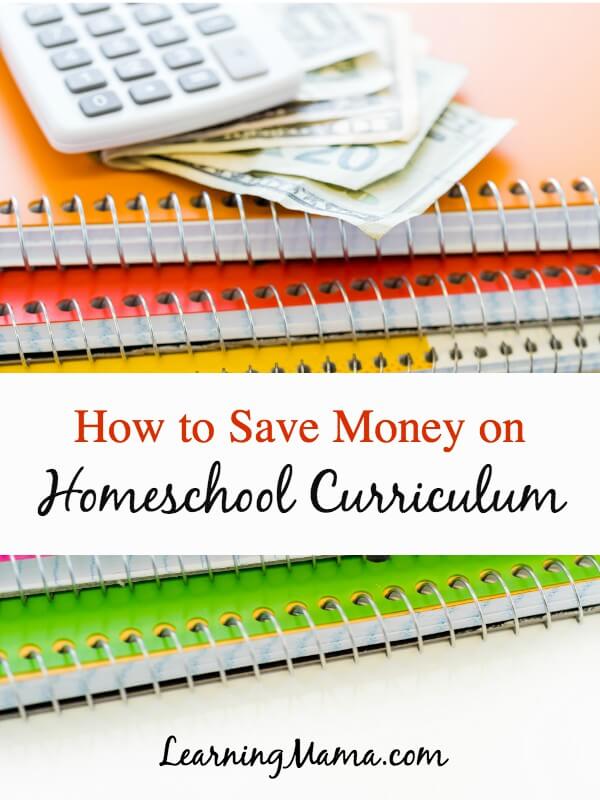There are many ways to homeschool for cheap or free, and a library card can and will take you far, but unless you have a lot of time on your hands and actually enjoy the work of creating your own curriculum, chances are you are going to want to purchase formal, prepared curriculum at some point in your homeschool journey.

This post contains affiliate links. Please see my disclosure policy for details.
There is a huge selection of homeschool curriculum available these days, and you can piece together your own from various sources or choose an all-in-one, boxed curriculum. Regardless of where on that continuum you find yourself shopping, there are ways you can save money on homeschool curriculum. Here are 7 ways I have saved a bundle over the years on homeschool curriculum, books and resources.
1. Borrow or Try Before You Buy
Before plunking down your cold hard cash on homeschooling materials, check and see if you can borrow from the library, a friend, or another local homeschooler. There are so many great curriculum choices out there, but it’s hard to know what will suit your needs, style, and preferences if you can’t preview it first. You can save a lot of money by being sure of your choices before spending a dime. Even better than trying before you buy is to just borrow something that someone else isn’t currently using.
2. Buy Used
So you’ve done your research, and hopefully previewed or tried out the materials you want to buy, now what? You can often save 50% or better off the price of books and curriculum by buying second hand. Your best bet for buying second hand is from local homeschoolers, thrift stores, and library sales if you can find them. In the past, I’ve scored some wonderful children’s classics for as little as 10 cents apiece, and several years worth of instructor’s manuals for our math program at less than half the price of new.
If you can’t find what you are looking for locally, it is still worth trying to look for used online. I use Facebook buy/sell groups for this purpose often, but you do have to be careful about the cost of shipping — sometimes it all but negates the cost savings after you factor it in. One of my favourite sources for books is Thrift Books, and they are great for finding books that are out of print. I’ve also found actual homeschool curriculum on there, so I always do my homework before buying new!
3. Choose Non-Consumable
Whenever possible, I choose books and materials that are non-consumable and can be used by all my children. If a program requires me to buy new workbooks/notebooks for each child, I’m going to think long and hard about using it.
An example of how this has influenced our choices is with our spelling curriculum. I was hesitant to spend what I thought was a lot of money on All About Spelling, but when I considered that the materials will be used for all of my children, it turns out to be quite cost-effective. A consumable workbook-based program would cost around $20 per year, per child. Because AAS is non-consumable, it’s a one time only cost, and after we are done with the program it is completely resellable!
4. Choose Reproducible
Just this past year I was really tempted to purchase a new writing program for our homeschool. It was classical. It was pretty. Everyone was raving about it. But it was NOT reproducible, so I passed.
What we are currently using has a generous photocopying and distribution policy that allows for unlimited copying for use within your own family, which is one of the reasons I love this particular publisher. And what’s more, our current curriculum is working perfectly well — it just isn’t new and shiny, which brings me to my next point……..
5. Use What You Have
This is a big one. If you want to save money homeschooling, it really helps if you stop switching from program to program and using a different curriculum for each child. I know the temptation is there, but you don’t always need that shiny new curriculum.
One of the reasons we homeschool is so that we can tailor each child’s education to their individual needs, but this doesn’t have to mean that we need to make a new purchase for each child! You can often adapt what you have to provide a personalized education for your child. A boring phonics program can be made more hands-on by using letter tiles, writing on a chalkboard, singing songs, and playing games.
Adapting and using what you already have can also save you a bundle when you’ve already purchased the wrong curriculum. My NotebookingPages.com Lifetime Membership has saved me multiple times when a curriculum I’ve purchased has turned out to be a poor fit. I’ve just substituted or supplemented with library books, printed co-ordinating notebooking pages and made do.
6. Choose Digital
Many homeschool resources are available in both physical and digital formats. Whenever the resource is not something I feel I need to be able to hold in my hands, or would be re-sellable, I chose digital. Digital versions almost always offer significant savings over physical ones, and you also often save significantly on shipping costs.
Digital resources are especially helpful when they are for printable, consumable student pages. It is so much easier to hit simply hit “print” rather than photocopy each page individually!
7. Simplify
Another great way to save money is to simplify the curriculum! Choose which subjects are non-negotiable to you, and toss the rest! Do you need a health curriculum? Geography? Art? Does a first grader really need spelling lessons?
Especially in the early years, eliminate curriculum purchases for as many subject areas as you can –and save that money for when your students are older — the prices only go up for older students!
How do you save money on homeschool curriculum? Do you have any money saving tips for homeschoolers? Share in the comments below!
Read More:
- 5 Reasons You Don’t Need that Shiny New Curriculum
- 5 Reasons We Love Well Trained Mind Press
- Homeschooling Art Without a Curriculum
- Adding Cooking to the Curriculum
- Our Relaxed Classical Homeschool Picks





These are great tips for saving money on curriculum. Over the years I think I’ve used all of these tips!